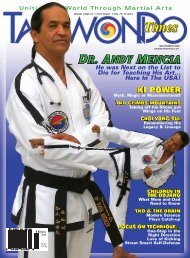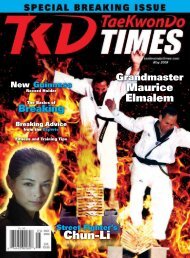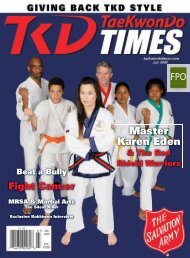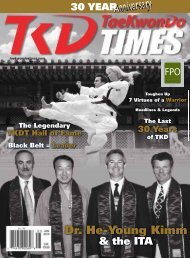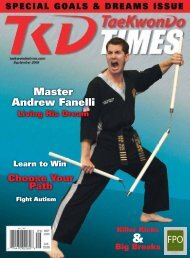Grandmaster Ken MacKenzie - Taekwondo Times
Grandmaster Ken MacKenzie - Taekwondo Times
Grandmaster Ken MacKenzie - Taekwondo Times
Create successful ePaper yourself
Turn your PDF publications into a flip-book with our unique Google optimized e-Paper software.
By Ste<br />
teph<br />
en<br />
DiL<br />
iLeo<br />
The student<br />
mounts the<br />
“Bob” bag in<br />
the same fashion<br />
he would<br />
mount an opponent.<br />
Student is free<br />
to rain down<br />
strikes with full<br />
power. Student<br />
learns how to<br />
generate force<br />
without the use<br />
of his hips.<br />
Where is it written that striking arts must<br />
remain standing? That is a common misconception.<br />
Somewhere along the way, the martial arts<br />
community ordained standup as the world of strikers<br />
and the ground as the exclusive domain of grapplers.<br />
However, nothing could be further from the<br />
truth!<br />
The first recorded Olympic wrestling match<br />
occurred in 708 B.C., but wrestling as an art may<br />
have existed over 4,000 years ago in China. The<br />
history of standup striking is also quite lengthy;<br />
as early as 50 B.C., Koreans were practicing the<br />
ancient striking art of Taek Kyon, which is the<br />
forerunner to modern day Tae Kwon Do. The<br />
fact is that determining which art was first may be<br />
impossible, but more importantly, it may be irrelevant.<br />
To ancient warriors, whether the fight was<br />
decided by blows or by grappling was most certainly<br />
not as important as winning the fight, which<br />
at that time, meant surviving to fight another<br />
day. The evolution of martial arts is about selfdefense,<br />
a fact often lost in the hype of modern-day<br />
competition. Based on that premise, fighters today<br />
should be no less concerned about survival than<br />
warriors of the past. Martial artists should not isolate<br />
their thinking to any preconceived restrictions<br />
about their particular style; in self-defense there are<br />
no rules about which techniques to use and where<br />
to use them.<br />
Generally, standup styles like TKD limit their<br />
training to striking only when on their feet. While<br />
it is not true that all fights either go to the ground<br />
or remain standing, it is true that all fights have the<br />
possibility of either circumstance. Why would any<br />
instructor or student want to gamble with their<br />
life? In fact, Mixed Martial Arts (MMA) fighters<br />
have proven that striking on the ground can<br />
be extremely devastating. Consider the number<br />
of matches that end in a knockout resulting from<br />
“ground ‘n pound” tactics. With just a little adjustment<br />
in technique and a big adjustment in strategy,<br />
standup arts like TKD can be very effective on the<br />
ground.<br />
At first, when strikers hit the ground, a strange<br />
spell comes over them and they forget to use all of<br />
their hard-earned skills—knees, elbows, punches,<br />
etc. Mr. Jim Del Real, chief instructor of the<br />
Penn State Korean Karate club, suggests that the<br />
most difficult challenge for students or instructors<br />
is mental, not physical. Del Real is a former<br />
Professional Karate Association (PKA) full-contact<br />
fighter and he knows only too well the effects of<br />
employing powerful strikes on the ground. Strikers<br />
need to go back to their roots and remember that<br />
the quality of techniques, not quantity, has more to<br />
do with the outcome of a fight.<br />
<br />
According to Del Real, the greatest challenge<br />
students and instructors face is to let go of their<br />
pride and accept that no single art is perfect or has<br />
70 November 2009 / taekwondotimes.com



